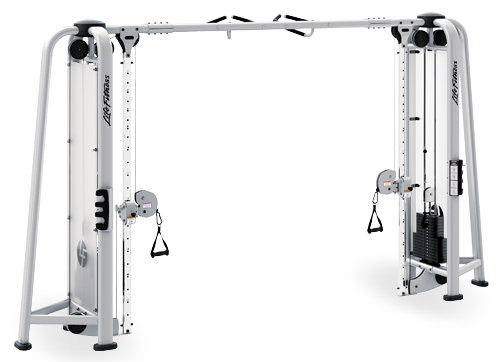The earliest cable crossover machines were designed by fitness legend Jack LaLanne. They are further improved by another fitness legend Harold Zinkin in the 1950s. Today, most gyms have a cable machine you can use for both weight and functional training. It’s typically a steel-framed structure, standing two meters high and about three meters wide, with weight stacks located on both sides and adjustable pulleys that you can set to any height. Cables run through the pulley (or a few of them) and connect to the weight stacks to be lifted. Since you can pull on the cables from different directions, the cable crossover machine can be used to train different groups of muscle, making it one of the most (if not THE most) versatile exercise machines around.
How it works?
When you use cable crossover machines, you are applying force to your muscles, the direction which you can freely alter with the help of the pulley. Weight stacks used by a cable machine for resistance are usually made of rectangular plates that weigh 10 or 20 pounds each. To utilize a weight, you simply have to slide in a pin through the plate, inserting it through the guide rods for the stack. To provide variation, different handles may be used, such as the short horizontal bar, parallel-arm lat bar, single-handed D-grip, double-handed low row bar, U- or V-shaped press-down bar, or an ankle collar.
Types of cable crossover machines
There are two main types of cable machines. They are:
- Fixed-resistance cable crossover machines feature the cables and pulleys arranged in a preset manner, where you lift the weight stacks by pulling down the handle at the end of the cable. With this cable machine, you’ll have to put more effort into certain parts of your exercise because your muscles change in length and due to the pull’s angle. It’s like the weight you are lifting during exercise changes, so your muscles are not put through the same kind of work in one movement. Maximum resistance on this cable crossover machine is felt where the joint’s angle is at its weakest. Some of the exercises you can do on a fixed-resistance cable machine include shoulder presses, bench presses, and triceps presses.
- Adjustable cable crossover machines are more common in gyms these days. They feature a wheel or cam that looks like a kidney bean. The movement of cables over the cam affects the weight stacks and the pivot point or axle over which the cam turns. During challenging exercises, the distance between the weight stacks and the pivot point decreases to make it easier to lift the weights. On the other hand, the distance increases when easier exercises are being performed to make the weights more difficult to lift. By making it possible to adjust the distance between the weight stacks and the pivot point, these machines can train muscles evenly throughout the motion. For isolating particular muscles, the adjustable cable machines are an excellent choice for single-joint exercises, like biceps curls, and multi-joint exercises, like overhead presses.
Is it for you?
Just the fact that a cable crossover machine is an exercise machine should be the point in its favor, do you agree? Brushing up on pros and cons about it will definitely give you a better idea as to what it can do for you and your fitness goals. Also, to paint a better picture of a cable crossover machine, it might be a good idea to get to know it in comparison to another popular means of getting fit: free weights.
Pros
Cable crossover machines are like free weights in that they allow you to do a large number of exercises. They are also both very easy to use and setting up requires little to zero effort. You also do not have to pay much attention to your coordination as the cable crossover machine pretty much takes care of stabilizing your body. It’s also easier to lift weights with the help of a cable machine so you end up lifting more compared to what you would have achieved with free weights. Not to mention that you can do away with training with a spotter because you can just let go of the cable when you cannot finish a complete repetition. The weights will just drop back on their stack without any danger of hurting you or the people around you.
Cons
Is there a negative side to cable crossover machines? There is, to some extent. Maybe it’s not exactly what you would call badly for you. However, it can affect your exercise efforts. How? By becoming so helpful in supporting your movements, a cable crossover machine takes away the work that your body does to stabilize muscles during exercise. Because your muscles don’t do the work they should have been doing, this reduces the effectiveness you could have benefited from. This is not exactly harmful to you, but it does mean that it may take you longer to achieve your fitness goals. You would not have to worry about that though if you were using free weights.
On the other hand, you can safely push yourself to the maximum with a crossover machine, much safer than with the free weights. Therefore, that can be a concern, but usually isn’t. What should be more worrying is the potential harm that can happen if you locked your arm in the motion. A cable crossover machine generally provides you a free range of movement, following the kind of movement that your body would naturally have. If you do unnatural movements, you will put yourself at risk of injury. Just be careful not to do exercises that will put your arms in some unnatural position.
Do you really need a cable crossover machine?
It depends on your fitness level and your fitness goals. If you’re a beginner or average user, then you probably don’t need it. It’s not that you can’t do similar workouts with another equipment, but since they are remarkable for strength and functional training, I suggest that you try it in your local gym and decide for yourself. Just make sure that all parts are secure, and start with a weight that’s suitable for your fitness level.
If you’re an advanced user, then you probably know what the benefits of using a cable crossover machine are.
 Best Home Gym Reviews and Tips for Your Home Gym
Best Home Gym Reviews and Tips for Your Home Gym







